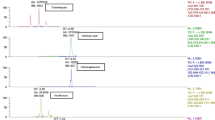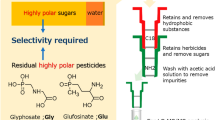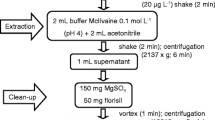Abstract
Herein, we constructed a platform of neutral desorption-extractive electrospray ionization mass spectrometry (ND-EESI-MS) for direct and rapid detection of chloramphenicol (CAP) in honey samples diluted with methanol. Under the optimized working conditions, the quantitative information of CAP residues was acquired effectively by EESI-Ion Trap MSn. Using heated methanol-N2 as spray reagent, we reduced the limit of determination (LOD) from 73.3 ng/mL to 0.3 ng/mL, and the CAP detection is linear in the range of 1–5000 ng/mL (R = 0.9947). For the honey samples with CAP of 10, 100, and 1000 ng/mL, the recoveries were 133.0, 80.6, and 101.1 %, and the relative standard deviations were 5.96, 8.82, and 8.71 %, respectively. The reproducibility assays showed the stability of this method. Therefore, this ND-EESI-MS method is powerful for direct, rapid, and quantitative CAP analysis in honey samples with high sensitivity, precision, and specificity.

In the current neutral desorption-extractive electrospray ionization mass spectrometry (ND-EESI-MS) method, N2 is inlet into samples to desorb chloramphenicol (CAP). We tried to use some organic solvents as the spray reagent to dissolve CAP, and then the best neutral desorption efficiency was obtained when using methanol. We applied this modified ND-EESI-MS method to detect CAP in honey samples only with sample dilution. The limit of CAP detection was then reduced from 73.3 to 0.3 ng/mL, reaching the current EU standard. Therefore, this is a powerful method for direct, rapid, and quantitative CAP analysis in honey samples.





Similar content being viewed by others
References
Wang JK (2008) The present conditions and existing problems in China’s exports of bee products. Agric Econ (Chin) 4:33–34
Yunis AA (1973) Chloramphenicol-induced bone marrow suppression. Semin Hematol 10(3):225–234
Allen EH (1985) Review of chromatographic methods for chloramphenicol residues in milk, eggs, and tissues from food-producing animals. J Assoc Off Anal Chem 68(5):990–999
Payne MA, Baynes RE, Sundolf SF, Craigmill A, Webb AI, Rivier JE (1999) Drugs prohibited from extralabel use in food animals. J Am Vet Med Assoc 215(1):28–32
(1994) Commission Regulation 1430/94 of 22 June 1994, Off J Eur Commun L 156: 6
Mutinelli F (2003) Practical application of antibacterial drugs for the control of honey bee diseases. Apiacta 38:149–155
(2002) Commission Decision 2002/657/EC of 12 August 2002 implementing Council Directive 96/23/ECD concerning the performance of analytical methods and the interpretation of results. Off J Eur Commun L 221:8–36
Fedorova MD, Andreeva IP, Vilegzhanina ES, Komarov AA, Rubtsova MY, Samsonova JV, Egorov AM (2010) Enzyme-linked immunosorbent assay of chlorampenicol in foodstuff. Appl Biochem Microbiol 46(8):795–801
Scortichini G, Annunziata L, Haouet MN, Benedetti F, Krusteva I, Galarini R (2005) ELISA qualitative screening of chloramphenicol in muscle, eggs, honey and milk: method validation according to the Commission Decision 2002/657/EC criteria. Anal Chim Acta 535(1–2):43–48
Wang L, Zhang Y, Gao X, Duan ZJ, Wang S (2010) Determination of chloramphenicol residues in milk by enzyme-linked immunosorbent assay: improvement by biotin-streptavidin-amplified system. J Agric Food Chem 58(6):3265–3270
Yang CD, Song LH, Mao LH, Liu MX (2004) Analytical method for the determination of chloramphenicol residues in shrimps. Chin J Anal Chem 32(7):905–907
Zhan CR, Guo P, Chen ZG, Wang YX, Hu ZG (2008) Determination of thiamphenicol and florfenicol residues in aquatic products by ultra performance liquid chromatography. Chin J Anal Chem 36(4):525–528
Santos L, Barbosa J, Castilho MC, Ramos F, Ribeiro CAF, da Silveira MIN (2005) Determination of chloramphenicol residues in rainbow trouts by gas chromatography–mass spectometry and liquid chromatography–tandem mass spectrometry. Anal Chim Acta 529:249–256
Impens S, Reybroeck W, Vercammen J, Courtheyn D, Ooghe S, de Wasch K, Smedts W, de Brabander H (2003) Screening and confirmation of chloramphenicol in shrimp tissue using ELISA in combination with GC-MS2 and LC-MS2. Anal Chim Acta 483(1–2):153–163
Vivekanandan K, Swamy MG, Prasad S, Mukherjee R (2005) A simple method of isolation of chloramphenicol in honey and its estimation by liquid chromatography coupled to electrospray ionization tandem mass spectrometry. Rapid Commun Mass Spectrum 19(21):3025–3030
Kaufmann A, Butcher P (2005) Quantitative liquid chromatography/tandem mass spectrometry determination of chloramphenicol residues in food using sub-2 μm particulate high-performance liquid chromatography columns for sensitivity and speed. Rapid Commun Mass Spectrum 19(24):3694–3700
Xie W, Ding HY, Zhang XD, Zheng ZQ, Xi JY, Yu CY (2005) Determination of chloramphenicol residue in honey and royal jelly by high performance liquid chromatography/mass spectrometry/mass spectrometry. Chin J Anal Chem 33(12):1767–1770
Ortelli D, Edder P, Corvi C (2004) Analysis of chloramphenicol residues in honey by liquid chromatography-tandem mass spectrometry. Chromatographia 59(1–2):61–64
Mackie J, Marley E, Donnell C (2013) Immunoaffinity column cleanup with LC/MS/MS for the determination of chloramphenicol in honey and prawns: single-laboratory validation. J AOAC Int 96(4):910–916
Pan C, Zhang H, Chen S, Xu Y, Jiang S (2006) Determination of chloramphenicol residues in honey by monolithic column liquid chromatography–mass spectrometry after use of quechers clean-up. Acta Chromatogr 17:320–327
Blachon G, Picard P, Tremblay P, Demers S, Paquin R, Babin Y, Fayad PB (2013) Rapid determination of chloramphenicol in honey by laser diode thermal desorption using atmospheric pressure chemical ionization-tandem mass spectrometry. J AOAC Int 96(3):676–679
Kara M, Uzun L, Kolayli S, Denizli A (2013) Combining molecular imprinted nanoparticles with surface plasmon resonance nanosensor for chloramphenicol detection in honey. J Appl Polym Sci 129(4):2273–2279
Yu X, He Y, Jiang J, Cui H (2014) A competitive immunoassay for sensitive detection of small molecules chloramphenicol based on luminol functionalized silver nanoprobe. Anal Chim Acta 812:236–242
Yang Q, Wang H, Maas JD, Chappell WJ, Manicke NE, Cooks RG, Ouyang Z (2012) Paper spray ionization devices for direct, biomedical analysis using mass spectrometry. Int J Mass Spectrom 312:201–207
Chen HW, Wortmann A, Zhang WH, Zenobi R (2007) Rapid in vivo fingerprinting of nonvolatile compounds in breath by extractive electrospray ionization quadrupole time-of-flight mass spectrometry. Angew Chem Int Ed 46(4):580–583
Li JQ, Zhou YF, Ding JH, Yang SP, Chen HW (2008) Rapid detection of toluene-2,4-diisocyanate in various sports fields using extractive electrospray ionization mass spectrometry. Chin J Anal Chem 36(9):1300–1304
Chen HW, Venter A, Cooks RG (2006) Extractive electrospray ionization for direct analysis of undiluted urine, milk and other complex mixtures without sample preparation. Chem Commun 19:2042–2044
Chen HW, Yang SP, Li M, Hu B, Li JQ, Wang J (2010) Sensitive detection of native proteins using extractive electrospray ionization mass spectrometry. Angew Chem Int Ed 49(17):3053–3056
Gu HW, Hu B, Li JQ, Yang SP, Han J, Chen HW (2010) Rapid analysis of aerosol drugs using nano extractive electrospray ionization tandem mass spectrometry. Analyst 35(6):1259–1267
Li X, Hu B, Ding JH, Chen HW (2011) Rapid characterization of complex viscous samples at molecular levels by neutral desorption extractive electrospray ionization mass spectrometry. Nat Protoc 6(7):1010–1025
Ding JH, Yang SP, Liang DP, Chen HW, Wu ZZ, Zhang LL, Ren YL (2009) Development of extractive electrospray ionization ion trap mass spectrometry for in vivo breath analysis. Analyst 134(10):2040–2050
Law WS, Chen HW, Ding JH, Yang SP, Zhu L, Gamez G, Chingin K, Ren YL, Zenobi R (2009) Rapid characterization of complex viscous liquids at the molecular level. Angew Chem Int Ed 48(44):8277–8280
Ding JH, Gu HW, Yang SP, Li M, Li JQ, Chen HW (2009) Selective detection of diethylene glycol in toothpaste products using neutral desorption reactive extractive electrospray ionization tandem mass spectrometry. Anal Chem 81(20):8632–8638
Chen HW, Lai JH, Zhou YF, Huan YF, Li JQ, Zhang X, Wang ZC, Luo MB (2007) Instrumentation and characterization of surface desorption atmospheric pressure chemical ionization mass spectrometry. Chin J Anal Chem 35(8):1233–1240
Chen HW, Hu B, Zhang X (2010) Fundamental principles and practical applications of ambient ionization mass spectrometry for direct analysis of complex samples. Chin J Anal Chem 38(8):1069–1088
Turnipseed SB, Clark SB, Storey JM, Carr JR (2012) Analysis of veterinary drug residues in frog legs and other aquacultured species using liquid chromatography quadrupole time-of-flight mass spectrometry. J Agric Food Chem 60(18):4430–4439
Bononi M, Tateo F (2008) Liquid chromatography/tandem mass spectrometry analysis of chloramphenicol in propolis extracts available on the Italian market. J Food Compos Anal 21(1):84–89
Bogusz MJ, Hassan H, Al-Enazi E, Ibrahim Z, Al-Tufail M (2004) Rapid determination of chloramphenicol and its glucuronide in food products by liquid chromatography–electrospray negative ionization tandem mass spectrometry. J Chromatogr B 807(2):343–356
Yin L, Xu L, Yu K, Zhen Y, Han X, Xu Y, Qi Y, Peng J, Tan A (2011) Orthogonal test design for optimization of suitable conditions to separateC-phycocyanin from Spirulina platensis by high-speed counter-current chromatography using reverse micelle solvent system. J Sep Sci 34(11):1253–1260
Acknowledgments
This study was supported by the 12th Five-rural Areas of the National Science and Technology Plan Project (No.2012BDA29B01), the National Natural Science Foundation of China (Grant No. 31071551), and the International Science and Technical Cooperation Program of Jiangxi Province (20121BDH80020).
Author information
Authors and Affiliations
Corresponding authors
Rights and permissions
About this article
Cite this article
Huang, X.Y., Fang, X.W., Zhang, X. et al. Direct detection of chloramphenicol in honey by neutral desorption-extractive electrospray ionization mass spectrometry. Anal Bioanal Chem 406, 7705–7714 (2014). https://doi.org/10.1007/s00216-014-8176-y
Received:
Revised:
Accepted:
Published:
Issue Date:
DOI: https://doi.org/10.1007/s00216-014-8176-y




